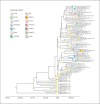COVID-19 Outbreak: An Overview
- PMID: 32259829
- PMCID: PMC7179549
- DOI: 10.1159/000507423
COVID-19 Outbreak: An Overview
Abstract
Background: In late December 2019, Chinese health authorities reported an outbreak of pneumonia of unknown origin in Wuhan, Hubei Province.
Summary: A few days later, the genome of a novel coronavirus was released (http://viro-logical.org/t/novel-2019-coronavirus-genome/319; Wuhan-Hu-1, GenBank accession No. MN908947) and made publicly available to the scientific community. This novel coronavirus was provisionally named 2019-nCoV, now SARS-CoV-2 according to the Coronavirus Study Group of the International Committee on Taxonomy of Viruses. SARS-CoV-2 belongs to the Coronaviridae family, Betacoronavirus genus, subgenus Sarbecovirus. Since its discovery, the virus has spread globally, causing thousands of deaths and having an enormous impact on our health systems and economies. In this review, we summarize the current knowledge about the epidemiology, phylogenesis, homology modeling, and molecular diagnostics of SARS-CoV-2. Key Messages: Phylogenetic analysis is essential to understand viral evolution, whereas homology modeling is important for vaccine strategies and therapies. Highly sensitive and specific diagnostic assays are key to case identification, contact tracing, identification of the animal source, and implementation of control measures.
Keywords: COVID-19; Pandemic; Phylogenesis; Protein modeling; Real-time polymerase chain reaction; SARS-CoV-2.
© 2020 S. Karger AG, Basel.
Conflict of interest statement
The authors have no conflicts of interest to declare.
Figures



Similar articles
-
The New Coronavirus COVID-19 Infection.Mol Gen Microbiol Virol. 2020;35(2):53-60. doi: 10.3103/S0891416820020044. Epub 2020 Sep 9. Mol Gen Microbiol Virol. 2020. PMID: 32929302 Free PMC article.
-
Assessment of the Prevalence and Incidence of COVID-19 in Saudi Arabia.J Multidiscip Healthc. 2023 Jan 24;16:227-236. doi: 10.2147/JMDH.S394038. eCollection 2023. J Multidiscip Healthc. 2023. PMID: 36718380 Free PMC article. Review.
-
Practical Strategies Against the Novel Coronavirus and COVID-19-the Imminent Global Threat.Arch Med Res. 2020 Apr;51(3):280-281. doi: 10.1016/j.arcmed.2020.03.005. Epub 2020 Mar 27. Arch Med Res. 2020. PMID: 32229157 Free PMC article.
-
Recommendations on the clinical management of the COVID-19 infection by the «new coronavirus» SARS-CoV2. Spanish Paediatric Association working group.An Pediatr (Engl Ed). 2020 Apr;92(4):241.e1-241.e11. doi: 10.1016/j.anpede.2020.02.002. Epub 2020 Apr 25. An Pediatr (Engl Ed). 2020. PMID: 32341943 Free PMC article.
-
[COVID-19 infection-update].Gefasschirurgie. 2020;25(6):389-396. doi: 10.1007/s00772-020-00691-8. Epub 2020 Sep 3. Gefasschirurgie. 2020. PMID: 32901177 Free PMC article. Review. German.
Cited by
-
Severe Acute Respiratory Syndrome-Associated Coronavirus 2 Infection and Organ Dysfunction in the ICU: Opportunities for Translational Research.Crit Care Explor. 2021 Mar 12;3(3):e0374. doi: 10.1097/CCE.0000000000000374. eCollection 2021 Mar. Crit Care Explor. 2021. PMID: 33786450 Free PMC article. Review.
-
COVID-19: A methyl-group assault?Med Hypotheses. 2021 Apr;149:110543. doi: 10.1016/j.mehy.2021.110543. Epub 2021 Feb 18. Med Hypotheses. 2021. PMID: 33657459 Free PMC article.
-
Clinical characteristics and outcome of hemodialysis patients with COVID-19: a large cohort study in a single Chinese center.Ren Fail. 2020 Nov;42(1):950-957. doi: 10.1080/0886022X.2020.1816179. Ren Fail. 2020. PMID: 32924707 Free PMC article.
-
A review of medications used to control and improve the signs and symptoms of COVID-19 patients.Eur J Pharmacol. 2020 Nov 15;887:173568. doi: 10.1016/j.ejphar.2020.173568. Epub 2020 Sep 19. Eur J Pharmacol. 2020. PMID: 32956644 Free PMC article. Review.
-
Comparison of Sexual Function Before and After COVID-19 Infection in Female Patients.Cureus. 2021 Sep 21;13(9):e18156. doi: 10.7759/cureus.18156. eCollection 2021 Sep. Cureus. 2021. PMID: 34692350 Free PMC article.
References
-
- Almeida JD, Tyrrell DA. The morphology of three previously uncharacterized human respiratory viruses that grow in organ culture. J Gen Virol. 1967 Apr;1((2)):175–8. - PubMed
Publication types
LinkOut - more resources
Full Text Sources
Other Literature Sources
Miscellaneous
